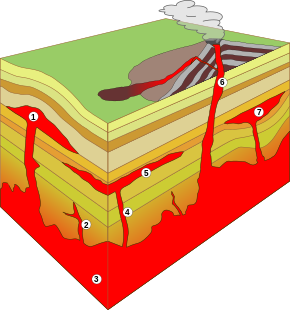
Back دغمور Arabic Lakkolit Azerbaijani Лаколит Bulgarian Lacòlit Catalan Lakolit Czech Lakkolith German Lacolito Spanish کوژسنگ Persian Lakkoliitti Finnish Laccolite French

A laccolith is a body of intrusive rock with a dome-shaped upper surface and a level base, fed by a conduit from below. A laccolith forms when magma (molten rock) rising through the Earth's crust begins to spread out horizontally, prying apart the host rock strata. The pressure of the magma is high enough that the overlying strata are forced upward, giving the laccolith its dome-like form.
Over time, erosion can expose the solidified laccolith, which is typically more resistant to weathering than the host rock. The exposed laccolith then forms a hill or mountain. The Henry Mountains of Utah, US, are an example of a mountain range composed of exposed laccoliths. It was here that geologist Grove Karl Gilbert carried out pioneering field work on this type of intrusion. Laccolith mountains have since been identified in many other parts of the world.

1. Laccolith
2. Small dike
3. Batholith
4. Dike
5. Sill
6. Volcanic neck, pipe
7. Lopolith
Note: As a general rule, in contrast to the smoldering volcanic vent in the figure, these names refer to the fully cooled and usually millions-of-years-old rock formations, which are the result of the underground magmatic activity shown.
© MMXXIII Rich X Search. We shall prevail. All rights reserved. Rich X Search